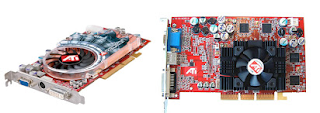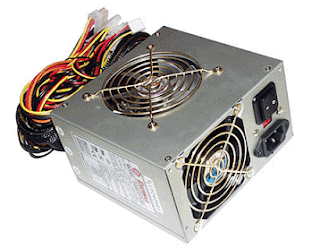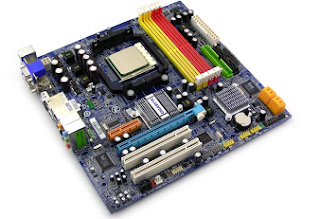at this time I will discuss about the parts of the computer (PC) as well as explain the function and meaning of the section. begin with the most important, up the small part that is no less important.
therefore, be prepared and consider the following discussion properly.
according to wikipedia
Computers are tools used to process the data according to the procedures that have been formulated. The word computer was originally used to describe people who perkerjaannya perform arithmetic calculations, with or without tools, but the meaning of the word is then transferred to the machine itself. Originally, the processing of information is almost exclusively related to arithmetical problems, but modern computers are used for many tasks unrelated to mathematics.
VGA CARD VGA
card is part of the computer, the CPU that is important to display the output process to monitor. Without VGA card, the computer screen will not display any blank alias. VGA card itself is a form of congenital extra slot or motherboard manufacturer, also called VGA on board. What form the VGA card? Please observe the image below.
therefore, be prepared and consider the following discussion properly.
according to wikipedia
Computers are tools used to process the data according to the procedures that have been formulated. The word computer was originally used to describe people who perkerjaannya perform arithmetic calculations, with or without tools, but the meaning of the word is then transferred to the machine itself. Originally, the processing of information is almost exclusively related to arithmetical problems, but modern computers are used for many tasks unrelated to mathematics.
VGA CARD VGA
card is part of the computer, the CPU that is important to display the output process to monitor. Without VGA card, the computer screen will not display any blank alias. VGA card itself is a form of congenital extra slot or motherboard manufacturer, also called VGA on board. What form the VGA card? Please observe the image below.
Sections,
among others, consists of a memory and a cooling fan. Same function,
which displays text and images to a monitor, only the colors and
different designs, depending on the manufacturers. The fan is needed to
cool the hot components of the VGA card, because this part works quite
heavy at any time. VGA card shown above is an additional VGA and not on
board (not integrated with the motherboard). profits VGA card on board
is that we can easily replace it with a new one when the damage
occurred, or want to improve the graphics performance of our computer.
CASING
Casing is part of the computer that serves as clothing, or protection from the CPU. The most common shape is a square box, but can be modified for those who love tinkering with this chassis. Aside from being a protector of CPU, the casing can also serve as additional cooling. Because usually, modern casing is currently equipped with a cooling fan that his number could be more than one.Another function is as a foundation for placing various other computer parts, especially the CPU, such as motherboards, VGA cards, sound cards, and others.As a patron, helpful casing to protect the inside from dirt or dust from collisions with other objects, so that the vital parts that would be safe and not easily damaged. In addition to the primary function, the casing can also be performed with a variety of colors and shapes to suit our desires. Certainly casing results of this modification is more expensive. Most important in the selection of casing is its main function. Computer so we are in a state that is safe and protected.
POWER SUPPLY
Power
supply Still inside the computer, stored in the CPU is power supply. As
the name implies this serves the power supply of electricity to any
part of the computer in order to run. Commonly used in the home PC was
kind of ATX. For more details see the image below.
The rear consists of a socket interface to monitor and electric power. There is also a fan, which cools the air inside the power supply box. The front part consists of small cables to supply power to each section in the CPU or the motherboard.
Of course, electricity flows have been minimal or reduced. While in power supply voltage electricity itself is still great, so is strictly prohibited to touch.
Of course, electricity flows have been minimal or reduced. While in power supply voltage electricity itself is still great, so is strictly prohibited to touch.
PROCESSOR
What is the processor? How can it be? Functions for what? Below will try to explain what that processor.
Processor is a very important part of the computer. He can be described as the computer brain. That is an electronic circuit that functions to logically respond and to process any instructions that turn on the computer.
Motherboard
this
article for those who want to know the contents of the CPU, such as the
motherboard or mainboard. A parent or a major part of which is in the
CPU. Functioning as a circuit board from a variety of other supporting components. Like what is the shape of the motherboard? Below is an example of a picture motherboard "Gigabyte GA-MA69GM-S2H".
You see the colorful it? It is a place holder for installing the cards are required, such as VGA card, memory card, TV tuner, video card, etc.
KEYBOARD, MOUSE AND MONITOR
Well, this part of the input. consists of a keyboard and mouse. In the late 1990s only a keyboard input device only. Subsequent developments began to emerge mouse, pen (pen-shaped). There is now nothing in the form of a finger touch input device (touch screen) and sound (command line). Commonly used for home computers is a keyboard and mouse. Its function is of course to enter data.
The latter is a monitor, output temporarily, because it only looks for temporary on-screen. Its function is to see the results of the input or the currently active program.
Memory
EXPLANATION WITH MEMORY FUNCTION AND FIGURES
Currently,
the term, the memory is used to describe data storage space that comes
into computer chips, and storage word itself is used to describe the
memory on the disk. Additionally, sometimes the term memory is usually
also used as an external memory device or a memory device that can be
taken anywhere. Some of today's computers also use virtual memory, which
has great power on a hard drive. Each computer is equipped with a
memory, and the memory is usually called the main memory or RAM is
called. In a computer's main memory is placed in the form of a row of
metal boxes.
Each computer can hold information in the form
of bytes. A computer that has 1 megabyte of memory can accommodate more
than one million bytes of information or character. There are several
types of memory, and below is the type and description
- RAM (random access memory)
This memory is the main memory. The term of this RAM memory is used to read and write data. With these functions you can perform two activities at once, the writing of RAM and read data from RAM. This is very different from the ROM, which only allow you to be able to read the data. Most of the data has a level of
instability to the less and it indicates that the power sign which
regulate the contents of RAM. And at any time when utility power fails,
then automatically the data in RAM is lost.
- ROM (read-only memory)
Almost a large number of computer has a ROM or Read Only Memory, which holds instructions for turning on a computer. Unlike RAM, ROM can not be used to write data.
- PROM (programmable read-only memory)
A PROM is a memory chip that can store programs. But once the PROM digu0nakan, we will not be able to clean up and restore other data.
- EPROM (erasable programmable read-only memory):
EPROM is a special type of memory PROM, EPROM which can be erased using ultraviolet light.
- EEPROM (electrically erasable programmable read-only memory)
EEPROM is a special type of PROM, EEPROM which can be removed by using the power supply voltage.
SRAM
(Static Random Access Memory) The word "static" indicates that the
memory holds its contents for electricity continues to run, not as
dynamic RAM (DRAM) which requires to "refreshed" ( "refreshed")
periodically. This is because SRAM is designed using the transistor without a capacitor. The absence of power capacitors made no leaking so that SRAM does not require periodic refresh. SRAM is also designed using design cluster of six transistors to store each bit of information.This design makes SRAM is more expensive but also faster than the DRAM. Physically chip, SRAM chip pemanufakturan costs approximately thirty times larger and more expensive than DRAM. But
it should not be dibingungkandengan SRAM read-only memory and flash
memory, because it is a volatile memory and holds data only when
electricity continue to be given. Random access indicates that the location in memory can be accessed,
read or written in a fixed time not considering the location of the
address data in memory.SRAM chips are commonly used as cache memory, it is mainly due to the speed. Currently
SRAM access time can be obtained with two nano-seconds or less,
approximately able to offset the processor speed of 500 MHz or more.
EDO RAM (Extended-Data-Out RAM) EDO RAM is actually nothing more than an increase in the FPM RAM. What is important is that most of the time when the CPU requests memory for something specific address, in addition to asking some other nearby addresses. In addition to urging each access memory refreshed, EDO RAM depending on the location of the previous access to flog access to the adjacent address. EDO RAM memory can speed up cycle, to improve performance in memory as much as 40 per cent. But EDO RAM is only effective for bass 66 Mhz and it may hasten again with shortcuts found on most current processors such as AMD, Cyrix and Intel.
SDRAM (Synchronous Dynamic Random Access Memory) Synchronous Dynamic Random Access Memory (abbreviated to SDRAM) is a type of dynamic computer memory used in PCs from 1996 until 2003. The SDRAM is also one kind of computer memory solid-state category. SDRAM, initially run at a speed of 66 MHz to be paired with an Intel Pentium Pro / Intel Pentium MMX / Intel Pentium II, and continues to be increased to a speed of 100 MHz (paired with Intel Pentium III / AMD Athlon), up stuck at a speed of 133 MHz ( paired with the Intel Pentium 4 and AMD Athlon / Duron). Its popularity declined when DDR-SDRAM is capable of transferring data twice as much SDRAM appeared on the market with a stable chipset. After that, as a result of an increasingly reduced production, the price is soaring, with the market demand is still much; with the same capacity with DDR SDRAM
DDRAM (Double Data Rate RAM) To know the computers we use to wear DDRAM or SDRAM, we use a software called Everest. In addition to using the software, we can also see the physical RAM, that is by reading on the RAM. Or you can also see the number of divider that exists in RAM or motherboard. If the boundary, which amounted to 1 piece, whereas if it means using DDRAM boundary, which totaled 2 pieces, then use SDRAM.
RDRAM has narrow path data (8 bit) but its performance can not be surpassed by any other type of DRAM data path wider than RDRAM is 16 bit or 32 bit. This is because in this RDRAM Memory Controller is enhanced. Of course, only motherboards that support Rambus DRAM that could wear this, such as motherboard for AMD K7 Athlon. However, this type of RAM used by 3dfx, Inc ,. to accelerate the process 3-dimensional depiction of an object filled by polygons. Examples of products that wear is 3dfx Voodoo4 series.
VGRAM (Video Graphics RAM) memory chip types VGRAM works well with video and achievements may see him on video accelerator card or on a motherboard that has video technology. Cip VGRAM typically used to store the content of pixels for an exposure chart. The use of chip VGRAM will provide video proper achievements and seeks to reduce the pressure on the CPU. Cip VGRAM involves the use of two ports of access to the memory cell and one thereof is used regularly to refresh the exposure and the other one is used to change the data that will be presented. The use of two ports can provide video offerings are worth compared with the use of chip DRAM and SRAM chips that have only one access port.
PROM (Programmable Read Only Memory) PROM (Programmable Read Only Memory) is a memory chip that can only be filled in with data only once. Once alone the program incorporated into a PROM, then the program will be at the next PROM. Unlike RAM, the PROM data will remain there even if the computer is turned off. The fundamental difference between the PROM and ROM (Read Only Memory) is that PROM manufactured as blank memory, whereas ROM has been programmed at the time produced. To write data on a PROM chip, it takes 'PROM Programmer' or 'PROM Burner'.
EPROM (Erasable Programmable Read Only Memory), EPROM (Erasable Programmable Read Only Memory) is a ROM that can be reprogrammed and erased. Based on the process of filling, there are two types of EPROM, namely UV EPROM and EEPROM. UV EPROM (Ultraviolet EPROM) require ultraviolet light to remove data contained in it, whereas EEPROM (electrical EPROM) that only uses electricity only in erasing or re-mem-program content.
EEPROM (Electrically Erasable Programmable Read-Only Memory) EEPROM stands for Electrically Erasable Programmable Read-Only Memory. EEPROM is a special type of PROM (Programmable Read-Only Memory) that can be removed by using an electrical charge. As with other types of PROM, EEPROM can store the contents of the data, even when the power is turned off.
EEPROM is very similar to flash memory, also called flash EEPROM. The fundamental difference between flash memory and EEPROM is writing and deletion performed on the data EEPROM is done by a single byte, while the flash memory erasing and writing of data is performed on the data of one block. Therefore flash memory faster. With regular ROM, BIOS replacement can only be done by replacing the chip.
While in EEPROM program will give instructions to the controller chip that provides electronic command and then download the new BIOS code for diidikan to the chip. This means companies can easily distribute new or updated BIOS, for example by using a floppy disk. It is also called flash BIO
PROM (Programmable Read Only Memory) PROM (Programmable Read Only Memory) is a memory chip that can only be filled in with data only once. Once alone the program incorporated into a PROM, then the program will be at the next PROM. Unlike RAM, the PROM data will remain there even if the computer is turned off. The fundamental difference between the PROM and ROM (Read Only Memory) is that PROM manufactured as blank memory, whereas ROM has been programmed at the time produced. To write data on a PROM chip, it takes 'PROM Programmer' or 'PROM Burner'.
EPROM (Erasable Programmable Read Only Memory), EPROM (Erasable Programmable Read Only Memory) is a ROM that can be reprogrammed and erased. Based on the process of filling, there are two types of EPROM, namely UV EPROM and EEPROM. UV EPROM (Ultraviolet EPROM) require ultraviolet light to remove data contained in it, whereas EEPROM (electrical EPROM) that only uses electricity only in erasing or re-mem-program content.
EEPROM (Electrically Erasable Programmable Read-Only Memory) EEPROM stands for Electrically Erasable Programmable Read-Only Memory. EEPROM is a special type of PROM (Programmable Read-Only Memory) that can be removed by using an electrical charge. As with other types of PROM, EEPROM can store the contents of the data, even when the power is turned off.
EEPROM is very similar to flash memory, also called flash EEPROM. The fundamental difference between flash memory and EEPROM is writing and deletion performed on the data EEPROM is done by a single byte, while the flash memory erasing and writing of data is performed on the data of one block. Therefore flash memory faster. With regular ROM, BIOS replacement can only be done by replacing the chip.
While in EEPROM program will give instructions to the controller chip that provides electronic command and then download the new BIOS code for diidikan to the chip. This means companies can easily distribute new or updated BIOS, for example by using a floppy disk. It is also called flash BIO
















0 komentar:
Posting Komentar